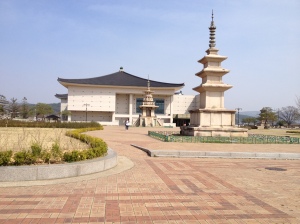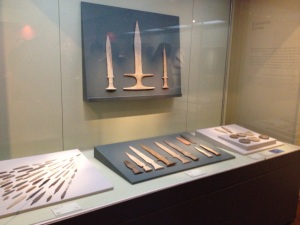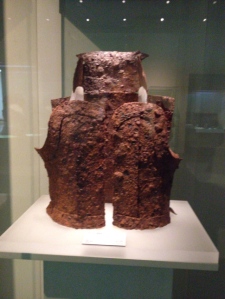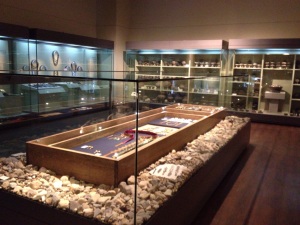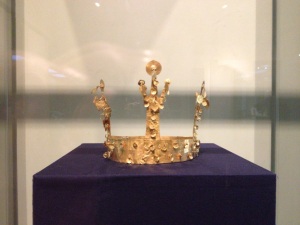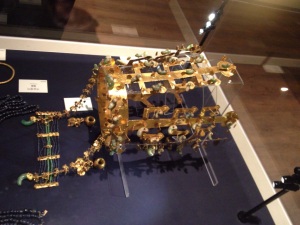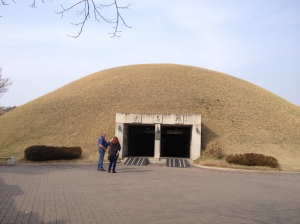After my friend and I visited the Bulguk-sa temple in Gyeongju, we headed for the Gyeonju National Museum in order to learn a little more about the nation’s history.
Most of what I had studied about Korea before visiting had to do with the political situation in North Korea, so I actually learned quite a bit at the museum and discovered that Korea has a fascinating history. The highlight of the National Museum is the artifacts from the Shilla (or Silla) dynasty, but they had all sorts of interesting artifacts from earlier eras as well.
I won’t go into too much detail about the peninsula’s history, but essentially the Shilla was one of what is known as the Three Kingdoms, which also include the Hubaekje and Goguryeo. The Shilla, Hubaekje, and Goguryeo were the most powerful kingdoms in Korea, and were eventually conquered and unified under the Shilla rulers. It’s fascinating stuff! The museum mostly had displays of armor, artwork, pieces of architectural ruins, and pottery, which were pretty cool to see.
There were quite a few clay vessels on display that were shaped like birds. Apparently these vessels were used in ancient funerary rites, after which they were buried with the deceased under the belief that the dead would ride the bird-shaped vessels to heaven.
But the crowning jewel of the museum’s exhibitions (no pun intended) were crowns that the Shilla royalty used to wear. Some of them were fairly simple pieces made of and ornamented with gold, but some were nearly three feet high with long, slender gold plates fitted with dangling shards of jade. The pieces of jade were cut into crescent shapes, smoothed, polished, and attached to the crowns. The crowns also had two long strings of gold and jade that would hang from the base of the crown nearly to the wearer’s shoulder, one on each side of the wearer’s head. The craftsmanship is absolutely breathtaking. The Shilla rulers also had intricately carved gold belts, earrings, bracelets, and ornamentation whose purpose I can’t even guess at, as well jade necklaces that had up seven individual strands of jewels. I can’t imagine how heavy it must have been to wear!
The aesthetics of the crowns and the belts reminded me a little of the crowns Egyptian Pharaohs used to wear, and the bird shapes on the vessels also reminded me of some Egyptian artwork I’ve seen pictures of. That might just be my imagination, though. Anyway, as I found out when I visited the tombs, the ancient Koreans did share a few verifiable cultural similarities with the Egyptians.
Just as the Egyptians made elaborate tombs for their rulers in which they buried their most precious possessions, the ancient Koreans made enormous burial mounds that served a similar purpose. From what I understand, most of the treasures that are in the Gyeongju National Museum were recovered from such tombs. In fact, there’s a large public park area in Gyeonju where you can walk around and view the various tombs that are still standing.
There’s also a smaller, private park that costs about a dollar to enter, in which several more tombs are enclosed—and you can actually go inside one of them! Maybe it’s morbid, but I was pretty excited to actually be inside a tomb where one of Korea’s ancient kings had been buried. Unfortunately no pictures are allowed inside the tomb, so I was only able to get pictures of the exterior:
That pretty much ended our day at Gyeongju, since we had hotel reservations in Seoul for that evening. I’m really happy we got to go there and learn so much about Korea’s history and culture, though. It certainly sparked my interest in the Shilla dynasty and the Three Kingdoms. But after that it was on to the KTX, where we headed for Seoul!

